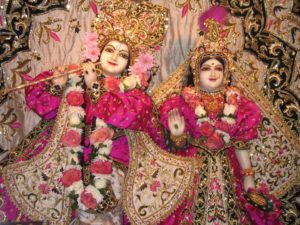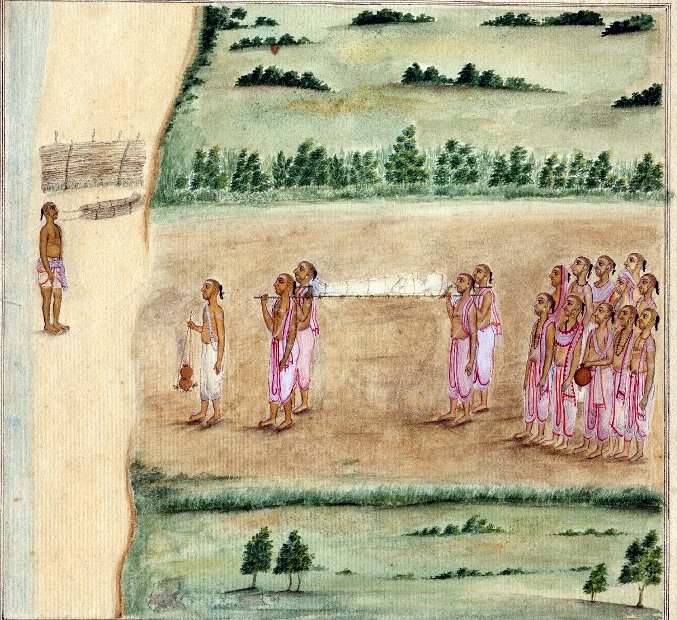Death is almost always seen as a conclusion, a time when life, existence, and vitality abruptly end. Although life may slowly diminish, at death there is no contention that what entity used to be there, no longer is. More importantly, death is inevitable to beings of the earth and thus an event they cannot avoid.
It is naive to postulate that death has a positive connotation; it is a dark time when the dying are in pain and their loved ones grieve. However, in many Hinduism-related texts, death has a drastically different tone. It is cast in a positive light in which characters achieve goals many have eternally sought. Often these goals are not achievable in life and entail becoming something completely different. Death is a dissolution process that brings beings to a new state of existence.
Death provides an evaluation of one’s karma thereby providing an avenue to greater varna.
Although not always apparent in the readings this quarter, the concept was illustrated in class since it is a main tenet of Hinduism. As humans live their lives, they make conscious decisions as to whether or not to fulfill the duties associated with their varna. Ultimately it is their actions that dictate whether they have been successful in their path of dharma. It is at the time of death when one can be judged and deemed worthy of progressing to new varna. Death is that opportunity that dictates what will be next.
 In the Puranas of Mahabharatha and Ramayana, death is utilized as a magical weapon that alters the states of existence of the cursed. In the Shree Krishna Leela Comics, Krishna encounters various demons that threaten innocent lives. Although many are rakshasas sent by Kansa, others are rather just cursed beings. It is only after Krishna killed these monsters that these beings reveal they’re true nature; more often than not, they were humans cursed to an infernal existence. Here, Krishna uses death to dissolve a curse and return people to their natural form.
In the Puranas of Mahabharatha and Ramayana, death is utilized as a magical weapon that alters the states of existence of the cursed. In the Shree Krishna Leela Comics, Krishna encounters various demons that threaten innocent lives. Although many are rakshasas sent by Kansa, others are rather just cursed beings. It is only after Krishna killed these monsters that these beings reveal they’re true nature; more often than not, they were humans cursed to an infernal existence. Here, Krishna uses death to dissolve a curse and return people to their natural form.
In the Ramayana, Ravana, the king of the rakshasas, is a strict devotee and performs so much tapas that he achieves immortality with a disclaimer. Although he has followed a path of dharma, his karma of kidnapping Sita seals his fate as cursed. However, due to Rama being his slayer, Ravana achieves divinity. Although death serves as a time of judgment for karma, it is also another opportunity to achieve a different destiny. Although Ravana should have been punished, a serendipitous death alters his fortune.
Desire has a relationship with death that dictates which type of existence a being will achieve or sustain.
In Samskara, the fate of Naranappa’s atman lays in the hands of his fellow Brahmins. After dying if one’s body is not cremated, one becomes a bhuta or a pisaca. Conversely, after cremation their atman achieves liberation from this limbo. Here, death is a conduit of other states of existence for an atman dependent on his community. In this example, the theme of desire is the issue that the Brahmins and the Archarya face in this dilemma; desire is thus the hinge upon which Narnappa’s existence teeters. In an anecdote in Aghora, the essence of one’s desire in the face of death directly translates into one’s next existence. A guru wants a nearby mango and this thought accompanies him to his death. In his immediately following state, he becomes an ant whose desire is solely the mango. The guru’s pupil understands the situation and therefore kills the ant, his guru, which brings his guru back to a better existence. Desire is a powerful factor in dictating one’s subsequent destiny; it’s all the more influential since the desire of the individual, peers, and the community can affect an individual’s next state of existence.
Life, in the face of death, can also bring about this change of existence.
In Ramayana, Sita’s reputation is tarnished from the stigma of having been in the adobe of Ravana. Although she herself does not take any disloyal action, Rama and society deem her tainted. To prove her purity, she consciously decides to step completely into the fire. For anyone else, this would entail an eventual death; however, due to her saintliness, the Fire chooses not to consume her. This act, called Sati, literally means, “being” or “existing.” Death is that force, which cancels out being or existence. Although death does not take away Sita’s life, life, in the face of death, brings about a renewed state of existence. Although she has remained pure, death’s inability to take her publicly demonstrates the truth, from which she can engage in a state of existence incapable without having confronted death.
In Aghora, life, in the face of death, can bring about liberation, a state of existence usually reserved for after death. Vimalananda embraces and becomes death by living in smashan, interacting with dead spirits, and transforming into the gods of death, Shiva and Kali. He also achieves a new state of existence before death by being judged by the criterion, desire, while still alive. He encounters his Ma, time and time again, who fulfills any desire that he has. Traditionally, this opportunity only presents itself after death. Vimalananda with his mantra and yantra brings about this Smashan Tara prematurely and since he lacks desire, he has the opportunity to achieve moksha. This asset of death became something Vimalananda aspires to take advantage of. Like Sita, although he has not died, he is not existing and living in the same manner prior to his deathly situation.
In these examples, death is a dissolution process that brings about changes in one’s state of existence. It is a powerful force but is heavily influenced by situations in life, whether it is a test of karma, kama, or dharma. Death marks the time when one state of existence must end, life, and another can begin. In the Manu Sastra, the cosmic man, Purusha, is sacrificed; upon his death, his physical attributes give way to the existence of part of the cosmos and the four varnas of man. Although death may be an end to sat, it’s true essence lies more deeply in creating sat.
-Glossary-
bhuta (ghost)
dharma (truth)
kama (desire)
karma (action)
pisaca (zombie)
rakshasa (demon)
sat (existence)
smashan (graveyard)
tapas (suffering/penance)
varna (social castes i.e. brahman (priest), kshatriya (warrior), etc.)






